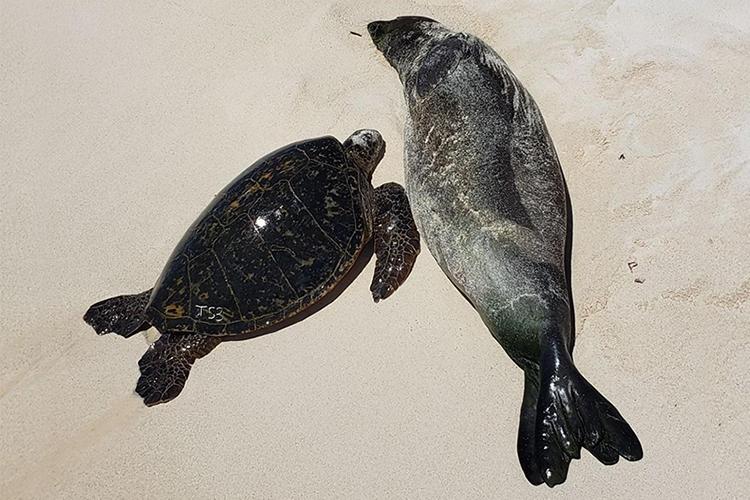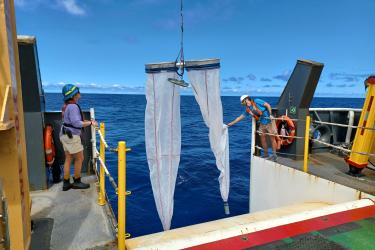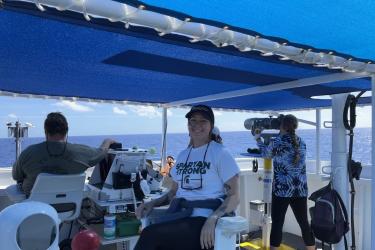For 40 years, NOAA Fisheries has been collecting critical data for endangered species within the Papahānaumokuākea Marine National Monument. We have gathered life history information on individual seals and turtles, survival rates, and rates of nesting turtles and seal pupping. This rich data set has allowed us to measure the impact of conservation activities, which contributed to an increase in the Hawaiian monk seal population to more than 1,500 individuals for the first time in more than 20 years!
This year was also momentous as we witnessed the first pups born to seals that had been rehabilitated at Ke Kai Ola, the Marine Mammal Center’s monk seal hospital in Kailua-Kona. We also evaluated green sea turtles’ adaptation to climate change. It takes planning, resiliency, adaptability, and strong partnerships to make each season a success. The 2022 field season had its share of challenges. In fact, this year’s buzzword was “unprecedented,” from inclement weather and subsequent early camp departures, to a record year for seals born. Here is the story of the exceptional 2022 field season and the partnerships that contributed to the mission’s success.
A Turbulent Start
The field staff were deployed on the NOAA Ship Oscar Elton Sette in May. During this cruise, persistent weather-related challenges led to delays, requiring regular alterations to our itinerary. Thanks to the Sette team’s adaptability and dedication, the field teams were well equipped for the season and we accomplished our mission successfully!
Success in the Field
Our field teams documented a record number of Hawaiian monk seal births this season, including at least 53 pups born at Kamole (Laysan). That’s the highest number at this location since 1999! Overall, we recorded at least 178 pups at the six major pupping sites within Papahānaumokuākea, the highest number since 2004. During the field season, teams at these six sites conducted 45 survival enhancing interventions. These included:
- Disentangling five seals from marine debris
- Releasing three pups entrapped in aging infrastructure at Lalo (French Frigate Shoals)
- Relocating 14 pups from an islet at Lalo with high shark predation risk to one where the risk is lower
- Collecting six pups for rehabilitation at Ke Kai Ola, The Marine Mammal Center’s hospital in Kailua-Kona, dedicated to the conservation of Hawaiian monk seals.
Other survival enhancing actions included reuniting separated mother-pup pairs, protecting pups from aggressive male seals, and providing antibiotics and other medications to compromised seals.
Field researcher Megan Ely shares her experience with the Kamole pups this year:
“This season at Kamole was much busier than any of us anticipated! We arrived at Kamole (Laysan Island) in late May and on our first survey of the island, we encountered a remarkable 26 nursing monk seal mom/pup pairs and 11 weaned pups! The first few weeks of camp were a whirlwind; on almost every survey, we encountered newborn pups as well as those that had recently weaned. Once pups wean, our team safely captures and handles each animal to apply unique tags for our population assessment.
In mid-June, a large number of pups weaned from their mothers all within a few days of each other in the same area; a time we called an MWE (mass weaning event). Typically, we conduct solo seal surveys and then meet up afterwards to apply the tags. But because we knew how many pups had weaned or were close to weaning, one day we set out with all three members of our team for a focused tagging mission. It would turn out to be the most memorable day for us this season. Midafternoon is typically the time when the highest number of seals are out on the beach, so we packed our tagging kit with extra supplies and set out after lunch. We carefully and quietly maneuvered around tagged seals and other animals in the area to minimize disturbance and started tagging seals, one at a time. Because there were so many seals in one area, we were able to safely capture and tag an impressive total of eight weaned pups in about 3 hours. Even with the extra supplies we had packed, we were still running low by the end of the day! This day was representative of a season that was a little overwhelming at times due to the sheer number of pups. However, once we realized what a momentous year it was going to be, we felt lucky to be there witnessing, recording, and reporting these special moments back to the excited team in Honolulu.”
During the field season, so many amazing things happened, and we met all challenges with open minds and a resilient mindset. We could not have succeeded without the help of numerous partners. The Papahānaumokuākea Marine Debris Project team aboard the M/V Imua provided critical support for our field camps and overall conservation efforts. This was especially true this year in the face of an unprecedented south swell that occurred in July.
Field researcher Paige Mino shares her account of that south swell on Manawai:
“Working and living on Manawai is extremely rewarding and our team this season took great pride in conducting population assessments on Hawaiian monk seals and green sea turtles. The concept of living on a beach and boating every day for work sounds idyllic, but it’s not without its challenges. It requires considerable adaptability from our team.
We dealt with boat issues all season, and on July 15 we were expecting to change a boat propeller and meet the Papahānaumokuākea Marine Debris Project team from the [charter vessel] Imua, who were delivering some much-needed boat parts. What started as any other day turned into a test of our team's versatility. We’d been informed about the historically large south swell coming through the Hawaiian Islands. We were planning to prepare our camp for it, but during lunch we got an unexpected call that would change the rest of our season.
The island we camp on, Southeast, has less than 6 feet of elevation, and we are able to see from one side of the island to the other. To err on the side of caution, we decided that our team would end the season at Manawai early and finish it at Midway. We had less than 5 hours to pack essential gear and prepare the camp for departure. I’ve never seen a team work so quickly and cohesively! In record time, the camp was as secure as possible and we began traveling to Midway where our team disembarked early the next morning. Leaving Manawai so early meant that we lost an entire month of our field season in that atoll. But, the silver lining was our team’s new opportunity to work on Midway. We surveyed a different atoll, tagged all weaned pups, and disentangled a pup whose chances of survival were otherwise low. Looking back on that day, I can’t help but be in awe of our team’s ability to respond so efficiently, and make the most out of our changing circumstances.”
Our partners at The Marine Mammal Center’s Ke Kai Ola hospital work hard in Kona to provide care for seals that are rescued from the Papahānaumokuākea Marine National Monument during the deployment and recovery missions. We were so pleased to be able to support the release of one of those patients in August at Kamole.
NOAA field camp teams worked with partner agencies at many sites. On Kamole, Kapou, and Midway, our staff and those from the U.S. Fish and Wildlife Service joined forces to enhance the value and impact of one another’s missions. Most notably, the U.S. Fish and Wildlife personnel on Kapou and Kamole conducted turtle nesting and basking tagging surveys. They provided critical and rare turtle data from the islands north of Lalo. They supported seal research activities, especially when we needed a larger team. On Midway, our field teams and U.S. Fish and Wildlife Service Midway Atoll National Wildlife Refuge staff collected data on seals and sea turtles. We trained their team to continue monitoring at Midway after the summer field season.
On Hōlanikū, our state partners at the Department of Land and Natural Resources and Kure Atoll Conservancy have a unique setup to support their year-round field efforts that includes a bunkhouse, kitchen, office, and storage space. They welcomed the NOAA team to their camp footprint and we were able to provide ship support aboard the Sette to swap out their personnel in May and August. This led to greater exchange of knowledge and partnership among the camps, added efficiency, and reduced our impact on the island. The Department of Land and Natural Resource team provides training and conducts periodic monk seal surveys during the off-season. This provides valuable information and the potential to conduct life-saving interventions, such as disentangling seals, when our team is not present.
We know that our presence in Papahānaumokuākea Marine National Monument is a great opportunity to support other projects. On Lalo, our field staff sampled seals with bite marks looking for shark DNA for the University of Hawai’i - Manoa, Hawai’i Institute of Marine Biology. The team also freed seabirds entrapped in aging infrastructure and provided transportation aboard the Sette to support the U.S. Fish and Wildlife Service’s effort to evaluate the island infrastructure.
The Lalo marine turtle field researchers share their favorite moments from this field season:
On Lalo, the turtle team celebrated a particularly rewarding season working with their beloved animals. Alex Reininger, the field camp leader, recalls her favorite moments working at night under the bright starry sky: “One night while walking along the beach looking for nesting turtles, a nest suddenly erupted right in front of me, scattering hatchlings everywhere. It’s rare to catch the beginning of a nest emergence. I felt extremely lucky to be in the right spot at just the right time, and watched in awe as the small hatchlings experienced the above ground world for the first time.”
Alex was also amazed at the changes at Lalo throughout the season and grateful that she was able to enjoy moments with these turtles that most people never experience: “It’s wild to think about how much had to happen for me to experience these moments, of watching these old turtles haul out of the water again decades after they were born here.”
The combined monk seal and turtle teams surveyed Tern Island at Lalo every day to look for wildlife that may have become entrapped in the island’s degrading seawall or other entanglement hazards. They saved 35 turtles, 3 seals, and 23 seabirds (20 ‘Iwa (great frigatebirds), 2 Noio Koha (brown noddies), and 1 Ka’upu (Black-footed albatross)).
Sometimes it isn’t an animal that needs saving out there, but our research equipment! Jamie Stoll, a veteran field camp assistant, described the time she and fellow assistant Andrew Glinsky helped fix an expensive satellite telemetry tag: “We were down on East Island when we saw turtle MG1 crawling down to the waterline after basking on shore. We had heard from Honolulu that she had a tag that needed to be fixed, so I sprinted down the beach and caught her before she could enter the water. While I carefully restrained the turtle, Andrew had to run to the other side of the island to retrieve our ‘turtle box’ so that we could safely contain her while we repaired the tag. The wooden sides of the box are big and heavy but Andrew ran his heart out to make sure we didn’t miss this opportunity. We were able to quickly reapply the turtle tag epoxy to MG1 and send her on her way, much to the relief of the entire program.”
Andrew recalled the time he had the opportunity to conduct a survey on one of the tiny spits that dot the outer islets of Lalo: “The spits were only about one turtle-length wide, and on this day there were five turtles and two monk seals all vying for a dry spot. With only enough space for one person to go to shore, my monk seal colleague stayed behind on the boat while I swam to the spit to survey the animals. The islet and surrounding water were so dynamic, that two of the turtles and one of the monk seals had already been half-buried in sand when I found them. I applied an identifier to an unmarked turtle and quietly took photos of the sleeping seals before heading back to the boat. It was so exciting!”
As a result of their hard work, the turtle team identified 635 unique turtles at Lalo this year. On Tern island, they observed 312 females and 144 males, or about half of what they observed during the 2021 “big year.” Because green turtles do not migrate to their nesting grounds every year, variations in the number of nesting females seen at Lalo are normal and expected. The team also applied satellite telemetry tags to six turtles (four males and two females) and sampled an impressive 71 nests! NOAA’s marine turtle program uses migration tracks and genetic samples to assess how Hawaiian green turtles are adapting to the changing climate.
Coming Home
Thanks to great weather and quick camp recoveries, we ended up ahead of schedule during our camp recovery trip. This allowed us to complete several secondary projects for our partners. We recovered and deployed two high-frequency acoustic recording packages (HARPs) , one at Manawai and one at Kona, part of the Cetacean Research Program’s Pacific Islands Passive Acoustic Network. We recovered and deployed two acoustic moorings, one at Middle Bank and one at Lalo, for the Hawaiian Islands Humpback Whale National Marine Sanctuary. Finally, we collected all 10 CTD (water conductivity, temperature, and depth) casts from their locations throughout the Monument for the long-term data set that is used in regional and national oceanographic modeling!
NOAA Fisheries collects critical monk seal and sea turtle data to learn more about these protected species and support their survival. This mission takes time, effort, and dedication. Relying on and helping our partners during these busy seasons makes all the difference. We couldn’t have done it without lots of support! We heard our field staff’s incredible stories and are so happy they are home after a successful season!
Meet the Blogger
Marylou Staman is a Marine Science Coordinator with NOAA’s Marine Turtle Biology and Assessment Program. She served as the Lalo turtle camp’s field leader for four seasons and now manages the program’s Papahānaumokuākea Marine National Monument green sea turtle research project from Honolulu. In 2022, Marylou spent nearly 60 days in the monument as Operations Lead and then Chief Scientist for the field camp deployment and recovery cruises onboard the Sette. Thank you to so many on our team who contributed to this story!










